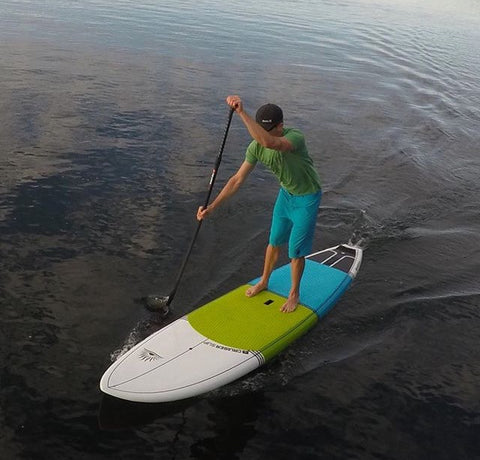Stand Up Paddle Boarding is no different from learning any sport - there are basic things you need to learn. However, some things like standing on your stand up paddle board backwards, or holding your SUP paddle incorrectly will give you away as a novice paddle boarder. Use these 5 essential tips to help you look like a pro, even if you aren’t!
Top 5 SUP’ing Mistakes You’re Probably Making
1. Picking the wrong conditions
If you have ever learned to ski or snowboard, your first run was most likely not down a black diamond. You (hopefully) found an easy run to start with, and then slowly progressed to harder. The same should apply to SUP. Start in some calm water, master the basics, and then move on as you are ready. Starting in rough, windy, choppy conditions will only lead to you getting very wet, and very frustrated.

2. Looking down at your feet
Try this - put your right hand on your left shoulder. Turn your head as far to the right as you can. More than likely you are going to feel your left shoulder moving a bit to the right. Why? Your body tends to follow where you are looking. For a new stand up paddle boarder looking down at your feet to make sure you are in the right place is a common mistake that makes it tough to balance. Make sure you set your eyes on the horizon in the direction you want to go instead of down at the water.

3. Falling in and Giving up
Any new sport may be a bit of a challenge at first. If you don't have any experience in other board sports/water sports there is a chance you will fall in once or twice while you learn. This is actually a good thing, because you’ll be learning how to get back up on your board once you’ve fallen off (which takes some practice).
Don't give up - everyone has a wipe out or two (or more!) under their belt while learning. As long as you get up one more time than you have fallen down, you are on the right track!

4. Standing on the board wrong
Boards have a nose/bow and a tail/stern. The tail/stern is the back of the board where the fin is. The nose/bow is the rounded or pointy end (if it’s a displacement board). The fin is 100% of the time always behind you, and your feet should be positioned near the carry handle on the board.

5. Holding the paddle backwards
A few of ways to make sure you have it correct:- Cruiser SUP paddles all have ergonomically designed handles, so making sure the handle is comfortable in your palm lets you know pretty quick if you’ve got it wrong. If it is uncomfortable, it is likely backwards.
- Paddles have an "off set" and the tip of the paddle should point towards the nose/bow of the board so you can pull your board past it (rather than dragging your paddle through the water)
- On Cruiser SUP paddles, the logo on the blade should always be pointing to the nose/bow of the board. If when paddling you can see the logo on the blade, your paddle is backwards

You might be a novice, but no one needs to know!
Stand up paddle boarding is a great sport to keep you fit and having fun on the water. Follow these tips and the fact that you are a novice stand up paddle boarder and not a seasoned SUP veteran will be your secret!
Have you seen, or made, any SUP newbie mistakes that we’ve missed? Comment below or email them to us at info@cruisersup.com - we would love to hear them!
About the Author
 Glenn Morton is Customer Experience Manager at Cruiser SUP, as well as chief content creator. Glenn has been stand up paddle boarding and windsurfing over 20 years, and has been with Cruiser SUP for over 15 years. When not on the water, Glenn can be found on his road bike, a ski hill, or raising his 12 year old daughter Nora. Glenn is an expert in all things paddle boarding including paddle board technique, SUP safety, and all paddle board products. Customers rely on Glenn's expertise to help guide them in their purchase of the best stand up paddle boards for their needs. Glenn helps equip thousands of paddle boarders each year, and is ready and waiting to help you.
Glenn Morton is Customer Experience Manager at Cruiser SUP, as well as chief content creator. Glenn has been stand up paddle boarding and windsurfing over 20 years, and has been with Cruiser SUP for over 15 years. When not on the water, Glenn can be found on his road bike, a ski hill, or raising his 12 year old daughter Nora. Glenn is an expert in all things paddle boarding including paddle board technique, SUP safety, and all paddle board products. Customers rely on Glenn's expertise to help guide them in their purchase of the best stand up paddle boards for their needs. Glenn helps equip thousands of paddle boarders each year, and is ready and waiting to help you.

